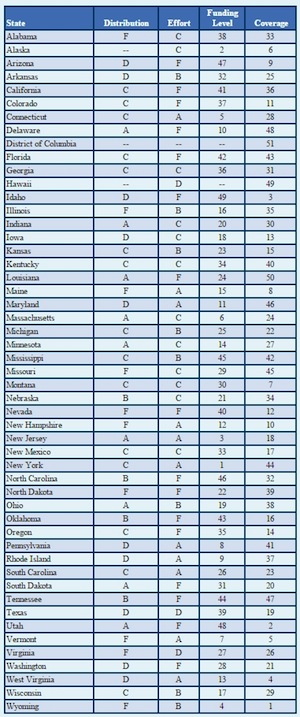Report: School Funding Mostly Unfair
- By Dian Schaffhauser
- 06/08/15
Policies and funding formulas for public schools differ so widely from state to state, researchers can identify gaps that vary by as much as
$12,138 between what is spent on students in one state vs. another. The disparity is greatest among low-income districts, according to the 4th
edition of "Is School Funding Fair? A National
Report Card," released by the Education Law Center (ELC).
Each year the ELC examines public school finance in the United States to understand the level and distribution of school funding,
particularly in relation to student need. The latest edition of the report is based on data from 2007 through 2012.
The report authors, David Sciarra and Danielle Farrie from ELC, and Bruce Baker from
Rutgers University, found that three out of five states are funding education on a per-student basis at a lower rate now than compared to
2008. 2012 funding levels range from a high of $18,507 in New York to a low of $6,369 in Idaho.
Very few states have a systematic way to provide additional funding to low-income districts. The funding gaps are exacerbated by state
adoption of the Common Core State Standards and new online assessments, which are "adding further stress on limited education budgets," the
report stated.
The concept of "fair" school funding is defined as a state finance system that provides a sufficient level of funding distributed to
districts that takes into account the extra needs generated by student poverty.
The report card "grades" states in four areas:
- Distribution, which looks at funding across local districts within a state, relative to student poverty. The importance of the number
is that it shows whether a state provides more or less funding to schools based on their poverty concentration;
- Effort, which measures differences in state spending for education relative to state fiscal capacity or state gross domestic product;
- Funding level, which examines the overall level of state and local revenue provided to districts and compares each state's average
per-student revenue. Each state's revenue level is adjusted to reflect differences in regional wages, poverty, economies of scale and
population density; and
- Coverage, which considers the proportion of school-age children attending the state's public schools vs. other schooling options and the
degree to which there is economic disparity between households in the public vs. private education system. This data is an important indicator
of a few things: First, the proportion of students enrolled in private school options affects the levels of financial support necessary for
public education. The extent to which wealthier families are more likely to opt out of public education has two important consequences: It
increases needs in schools by further concentrating poverty, and it may affect the public and political will necessary to generate fair
funding through the state's finance formula.
 As the chart to the right shows, only one state — New Jersey — receives As for distribution and effort. The state comes in number three on
funding levels and it ranks 18th in coverage; the income disparity between families who opt for public vs. non-public school options (87
percent and 13 percent, respectively) is about 40 percent.
As the chart to the right shows, only one state — New Jersey — receives As for distribution and effort. The state comes in number three on
funding levels and it ranks 18th in coverage; the income disparity between families who opt for public vs. non-public school options (87
percent and 13 percent, respectively) is about 40 percent.
On the other end of the spectrum, North Dakota and Nevada both received double Fs on distribution and effort in the report. They come in
22nd and 40th for funding levels and have coverage rankings of 39th and 12th, respectively. The researchers found that the poorest districts in
Nevada have about 30 percent more pupils per teacher in a state where regressive and low funding levels already result in "comparatively large
pupil-to-teacher ratios." High-poverty districts in North Dakota have, on average, 50 percent fewer pupils per teacher than low-poverty
schools, potentially resulting in smaller class sizes.
Other findings in the report card include:
- 14 states have "regressive" school funding. These states, including Texas, Pennsylvania and Illinois, provide less funding to districts
with higher concentrations of poor students;
- 19 states have "flat" school funding systems, failing to provide any appreciable increase in funding to address the needs of students in
high poverty districts. These include California, Florida, Colorado and Washington; and
- Only four states — Minnesota, Massachusetts, New Jersey and Delaware — have fair school funding systems. These states have a sufficient
overall level of funding and provide significantly higher amounts of funding to high poverty school districts.
"Public school funding in far too many states remains unfair, irrational and unconnected to the resources students must have to succeed,"
said Sciarra in a prepared statement. "These states' failure to provide fair school funding strikes hardest at the over 11 million poor,
school-aged children across the United States."
Added Baker, "These latest findings show a lack of access to preschool, higher pupil-to-teacher ratios and uncompetitive wages for teachers
in those states with unfair and inadequate school funding."
The complete report is available on the "Is
School Funding Fair?" site.
About the Author
Dian Schaffhauser is a former senior contributing editor for 1105 Media's education publications THE Journal, Campus Technology and Spaces4Learning.